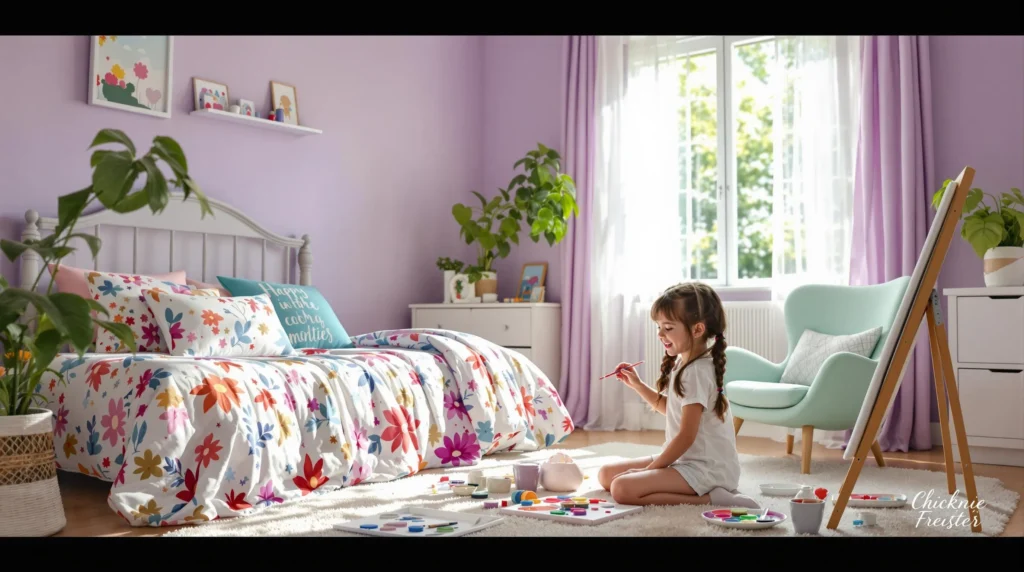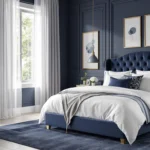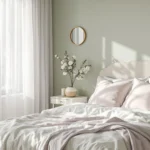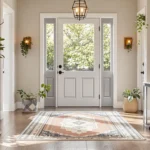Choosing the perfect paint color for your daughter’s room can transform an ordinary space into a magical sanctuary that reflects her personality and sparks creativity. From soft pastels to bold statement hues, the right color sets the foundation for a room she’ll love growing up in.
We’ve researched and gathered the most popular and versatile paint colors that have proven successful in girls’ rooms across various age groups. Whether you’re designing for a toddler, tween, or teenager, our expert recommendations will help you select shades that can adapt and evolve with her changing preferences over the years. Get ready to discover timeless classics and trending colors that will create the perfect backdrop for your daughter’s dreams and adventures.
10 Best Paint Colors for Girls’ Room That Inspire Creativity
1. Soft Lavender
Soft lavender creates a serene yet imaginative atmosphere that’s perfect for girls of all ages. This gentle purple hue promotes calmness while still offering enough visual interest to spark creativity. Many designers recommend Benjamin Moore’s “Lavender Mist” or Sherwin-Williams’ “Enchant” for a balanced tone that isn’t too overwhelming. These shades pair beautifully with white furniture and gold accents, creating a sophisticated space that can grow with your daughter.
2. Blush Pink
Blush pink offers a timeless appeal that transcends typical girly stereotypes with its sophisticated undertones. This versatile color works well from nursery to teen years because it’s subtle enough to complement changing décor styles. Parents often choose Behr’s “Positively Pink” or Valspar’s “Ballet Slipper” for their warm, inviting qualities. These shades create a peaceful backdrop that enhances focus and creative thinking without overwhelming the senses.
3. Mint Green
Mint green delivers refreshing energy while maintaining a gentle presence that encourages imaginative play. This nature-inspired color introduces a touch of the outdoors, promoting tranquility and mental clarity. Professional decorators frequently suggest PPG’s “Mint Condition” or Benjamin Moore’s “Fresh Mint” for their versatility with various décor styles. These cooling tones look stunning with natural wood furniture and botanical accents, creating a balanced environment where creativity can flourish.
4. Sky Blue
Sky blue evokes feelings of boundless possibility and open-minded thinking, making it ideal for creative endeavors. This cheerful yet calming shade helps reduce stress while stimulating positive thought patterns. Many interior designers recommend Sherwin-Williams’ “Cloudless” or Behr’s “Watery” for their true-to-nature quality. These blue tones create an expansive feeling in smaller rooms and pair wonderfully with crisp white trim and colorful accessories.
5. Sunny Yellow
Sunny yellow infuses any space with optimism and creative energy that naturally boosts mood and cognitive function. This vibrant color stimulates intellectual curiosity while creating a cheerful atmosphere for daily activities. Parents often select Sherwin-Williams’ “Sunbeam” or Benjamin Moore’s “Hawthorne Yellow” for their warm but not overwhelming qualities. These shades work particularly well in rooms with northern exposure that need additional brightness.
6. Coral
Coral combines the energy of red with the softness of pink to create a balanced, confidence-boosting environment. This ever-changing color encourages self-expression while maintaining enough sophistication for growing girls. Design experts frequently recommend Valspar’s “Coral Reef” or Behr’s “Marquee Coral” for their perfect balance of vibrancy and restraint. These warm-toned colors look striking against white furniture and complement navy or teal accents beautifully.
7. Periwinkle
Periwinkle blends the tranquility of blue with the playfulness of purple, creating a uniquely inspiring backdrop for creative activities. This dreamy color evokes imagination while maintaining a peaceful ambiance that supports concentration. Many interior designers suggest Benjamin Moore’s “Blue Viola” or Sherwin-Williams’ “Rhapsody Lilac” for their versatile undertones. These shades transition seamlessly from childhood to adolescence, pairing wonderfully with both pastel and bold accent colors.
8. Sage Green
Sage green brings natural harmony into any space with its earthy sophistication that promotes balance and creative thinking. This muted tone creates a grounding effect while still offering enough character to inspire artistic expression. Parents frequently choose Farrow & Ball’s “Mizzle” or Behr’s “Sagey” for their adaptability across different lighting conditions. These nature-inspired greens create an excellent foundation for botanical themes or woodland-inspired décor.
9. Peachy Cream
Peachy cream offers warmth and softness that’s both inviting and stimulating to the imagination. This gentle hue provides enough color interest without overwhelming the senses or limiting décor options. Design professionals often recommend Benjamin Moore’s “Peach Parfait” or Sherwin-Williams’ “Cosmetic Blush” for their flattering glow. These tones create a natural light-improving effect that makes rooms feel larger and more welcoming for creative play and projects.
10. Lilac Gray
Lilac gray delivers sophisticated modernity with just enough color to inspire without distracting. This complex neutral provides depth and interest while allowing other elements in the room to shine. Designers frequently suggest Behr’s “Violet Vista” or PPG’s “Lilac Smoke” for their chameleon-like quality that shifts subtly with changing light. These versatile shades work beautifully in minimalist designs or as backdrops for more colorful décor schemes, growing effortlessly with your daughter’s changing tastes.
Exploring Soft Pastels: Gentle Hues That Grow With Your Child
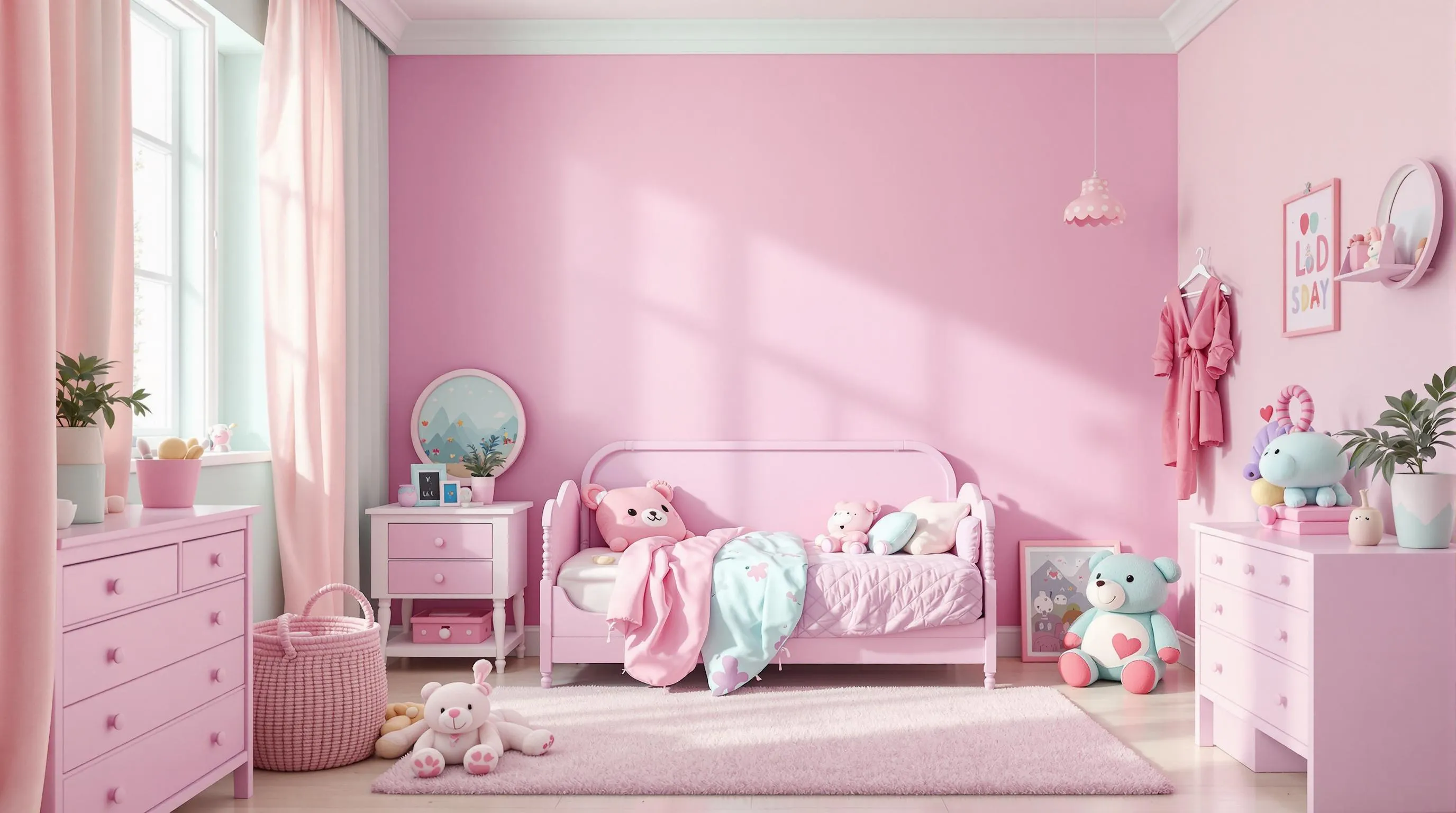
Soft pastels offer a versatile palette that evolves beautifully as your child grows from toddler to teen. These gentle colors create calming environments while maintaining enough character to remain relevant through different developmental stages.
Soft Pink: A Versatile Foundation
Soft pink provides a classic foundation that works wonderfully for girls of all ages. This timeless shade creates a naturally calming atmosphere while offering incredible versatility when paired with neutral tones like white or gray. Many parents find that soft pink walls allow for easy decor updates as their daughter’s interests evolve, maintaining its appeal from nursery days through adolescence.
Lavender Dreams: A Soothing Sanctuary
Lavender stands out as an exceptional choice for its proven calming effects, making it perfect for creating a peaceful sleep environment. This beautiful hue strikes an ideal balance between purple’s vibrant energy and the serenity of pastel tones. Parents appreciate how lavender pairs harmoniously with neutral colors or soft greens to create a cohesive look. The versatility of this shade makes it suitable for both young children and teenagers alike.
Mint Green: Refreshing Tranquility
Mint green delivers a refreshing take on pastels that feels both playful and sophisticated. This cool-toned option creates a tranquil backdrop that supports imaginative play while remaining age-appropriate for years to come. Designers often recommend mint green for its remarkable ability to complement both bold and neutral decor elements, giving parents flexibility as their daughter’s style preferences evolve.
Aqua and Turquoise: Playful Versatility
Aqua and turquoise shades inject playful energy into any girl’s room while maintaining the gentle quality of pastels. These colors create a versatile canvas that adapts to various themes from mermaid adventures to sophisticated teen retreats. Their connection to water elements brings a natural calming influence that helps establish a peaceful environment conducive to rest and creativity.
Vibrant Options: Bold Colors for Expressive Personalities
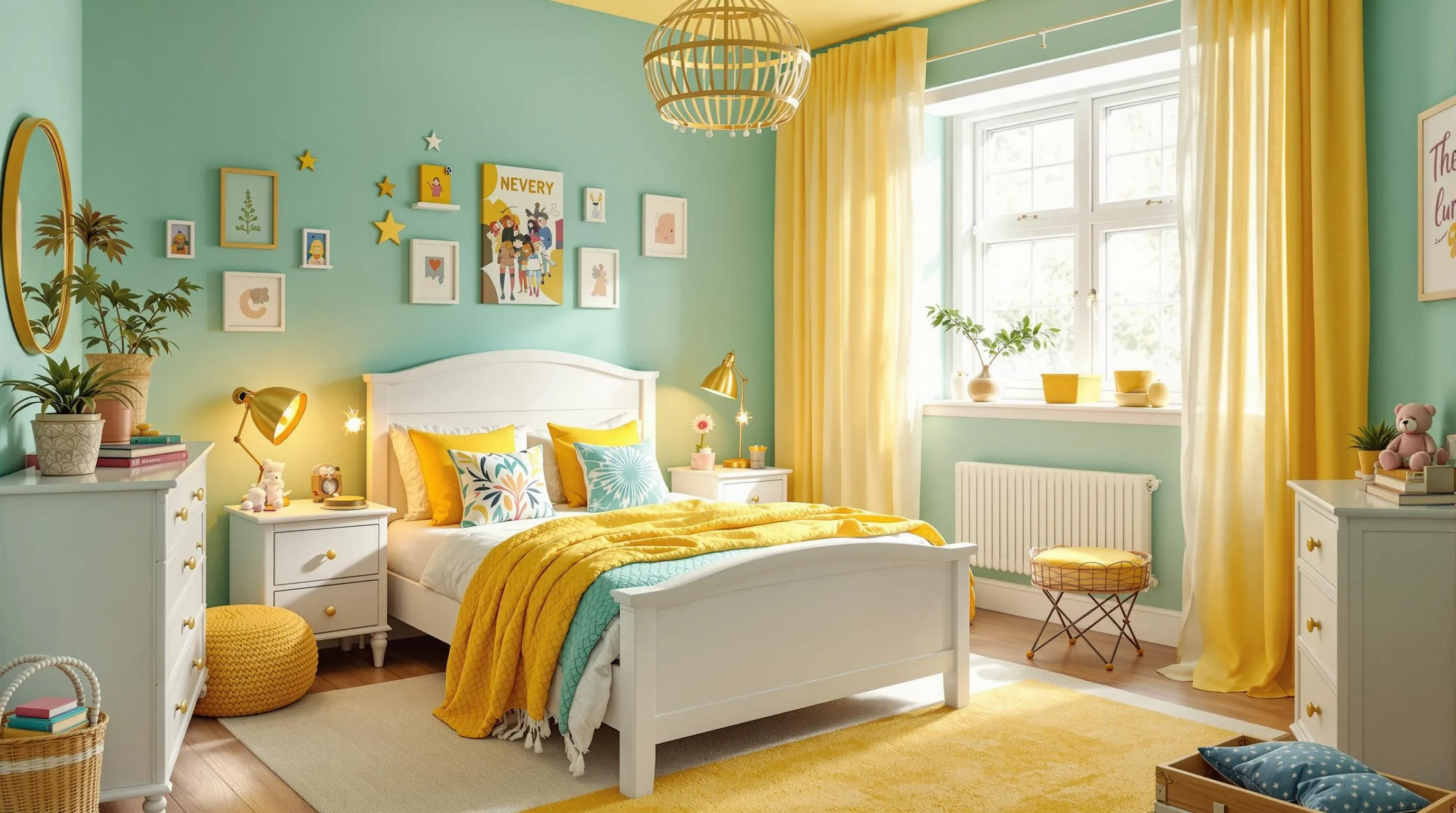
For girls with more daring personalities, vibrant colors can create the perfect backdrop that matches their energy and creativity.
Turquoise Delight: An Energetic Yet Calming Choice
Turquoise brings the perfect balance of energy and tranquility to a girl’s bedroom. This stunning aqua-inspired shade creates a lively atmosphere while still maintaining a serene undertone that works beautifully in sleeping spaces. Many interior designers recommend turquoise for its versatility in pairing with various accent colors from coral to navy. The ocean-inspired hue encourages creativity and self-expression, making it ideal for artistic children who love to showcase their personality. Turquoise walls provide a stunning backdrop for white furniture and gold accents, creating a space that feels both refreshing and sophisticated.
Sunshine Yellow: Bringing Happiness and Warmth
Sunshine yellow instantly transforms a bedroom into a cheerful sanctuary filled with positive energy. This vibrant shade has been shown to stimulate mental activity and promote feelings of happiness throughout the space. Decorating with yellow creates a warm, welcoming environment that feels cozy even on cloudy days. Parents often choose this color for its mood-boosting properties, particularly in rooms with limited natural light. The brightness of sunshine yellow pairs beautifully with white trim and furniture for a clean, fresh look that grows well with a child. Adding gray or navy accents helps balance the intensity of this bold color choice while maintaining its uplifting qualities.
Sophisticated Neutrals: Creating Versatile Spaces
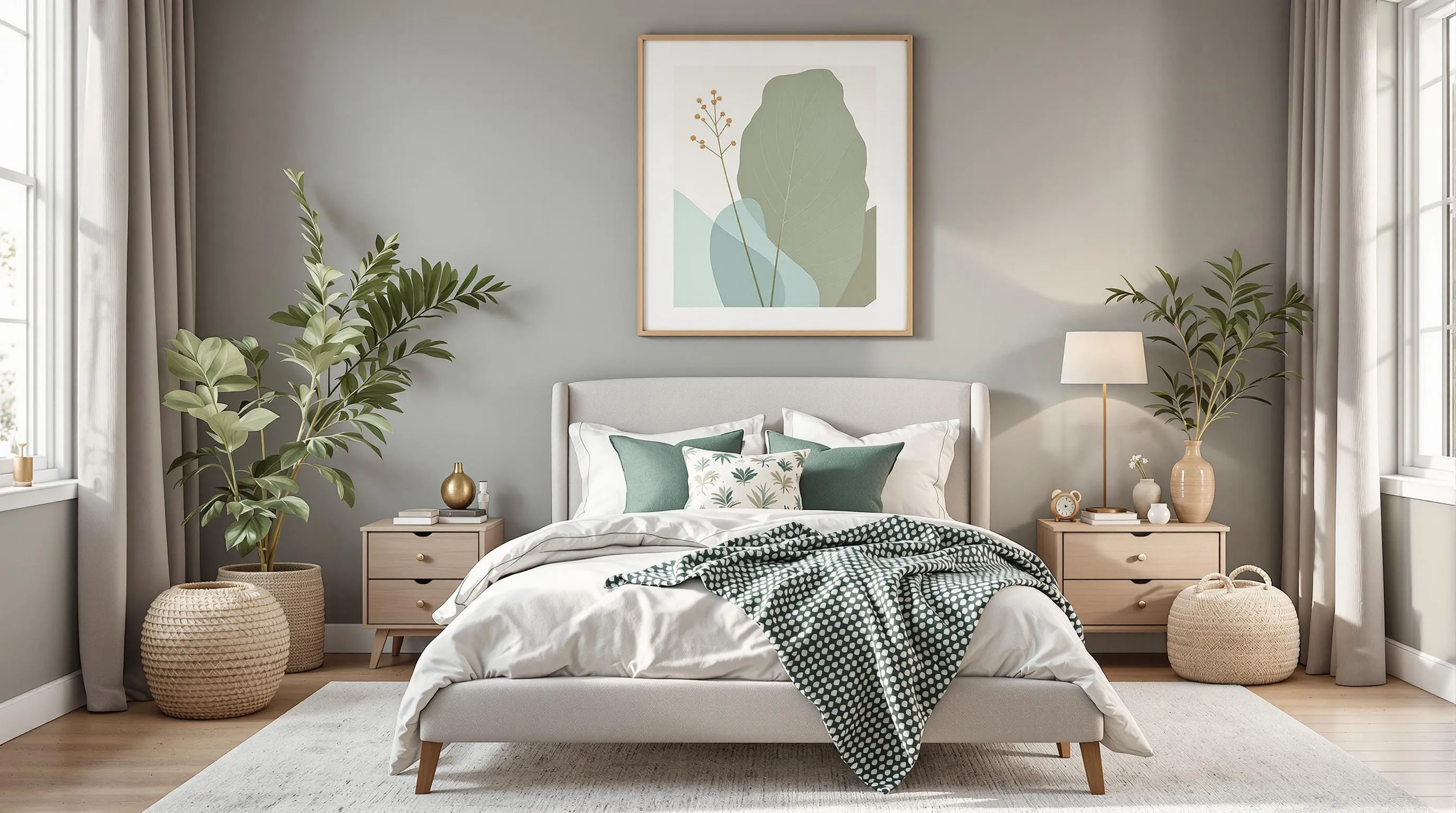
When designing a girl’s room that can grow with her through the years, sophisticated neutrals offer timeless appeal and incredible flexibility for changing tastes and styles.
Warm Gray: The Modern Alternative to Pink
Warm gray stands as a contemporary alternative to traditional pink, providing a clean, balanced foundation for any girl’s bedroom. This sophisticated neutral creates a soothing atmosphere while offering remarkable versatility for various decor styles. Benjamin Moore’s Silver Satin exemplifies this perfectly, serving as an ideal backdrop that effectively neutralizes bold bedding and vibrant artwork. Parents appreciate warm gray tones for their ability to transition seamlessly from childhood to adolescence without requiring frequent repainting. These shades pair beautifully with accent colors that can be easily updated through accessories as your daughter’s preferences evolve.
Mint Green: Fresh and Versatile Appeal
Mint green delivers a refreshing atmosphere that balances energy with tranquility in your daughter’s space. This versatile shade has gained popularity for its calming properties while maintaining a cheerful presence that works for girls of all ages. Mint green pairs excellently with pastel hues and natural decor elements, creating a cohesive look that feels both modern and timeless. Many designers recommend this color for its ability to adapt to changing themes – from fairy tales in early years to more sophisticated styles during teenage years. The subtle vibrancy of mint green promotes a sense of serenity while still offering enough character to inspire creativity and imagination.
Themed Color Schemes: Coordinating With Existing Decor

When designing a girl’s room, starting with a neutral base color gives you maximum flexibility as your child’s tastes evolve. Benjamin Moore Ivory White (CC-130) and White Sand (OC-10) provide timeless backdrops that adapt easily to changing decor styles. These versatile neutrals work perfectly with accent walls in colors like Sherwin-Williams Dew Drop (SW-9641), a delicate pale blue, or Softened Green (SW-6177), a sophisticated gray-toned moss shade. For rooms filled with bold textiles and artwork, we recommend Benjamin Moore Silver Satin (856), a soft gray that balances eclectic design elements without competing for attention.
Ocean Blue: Perfect for Mermaid-Themed Rooms
Sherwin-Williams Dew Drop (SW-9641) creates a serene underwater atmosphere ideal for mermaid-themed bedrooms. This pale blue shade evokes the peaceful feeling of ocean waters while maintaining a sophisticated look that won’t feel childish as your daughter grows. Layering aqua or turquoise accents throughout the room adds dimensional depth to the oceanic theme. Many designers enhance these maritime color schemes with metallic finishes such as silver or seafoam green accents that mimic the magical reflection of sunlight dancing on water. The result is a tranquil space that feels both whimsical and elegant.
Coral Charm: Balancing Energy and Elegance
Coral tones bring warm energy to a girl’s room while maintaining an air of sophistication that appeals to various age groups. This vibrant yet refined color pairs beautifully with Benjamin Moore White Sand (OC-10) to create perfect balance in the space. Sherwin-Williams Coral Rose (SW-9005) offers a slightly subdued alternative that aligns with age-neutral design principles. Coral shades work exceptionally well in rooms that need a boost of cheerful energy without overwhelming the senses. The versatility of these warm hues allows them to complement many design styles from bohemian to modern minimalist, making them smart choices for rooms intended to grow with your daughter through different developmental stages.
Color Psychology: How Paint Choices Affect Mood and Behavior

Paint colors do more than just decorate a space—they actively influence how we feel and behave. Understanding color psychology can help parents make more informed decisions when selecting the perfect shade for their daughter’s room. Let’s explore how different colors impact mood and behavior in girls’ bedrooms.
Calming Colors for Better Sleep
Soft pinks and lavenders aren’t just traditionally feminine choices—they’re scientifically proven to promote relaxation. These gentle hues create a soothing atmosphere that reduces stress and encourages better sleep quality. Soft pink combines feelings of femininity and comfort, making it an excellent choice for bedrooms where rest is a priority. Lavender, with its serene properties, encourages restfulness and peaceful slumber for girls of all ages.
Energizing Colors for Creativity
Vibrant colors like sunshine yellow and turquoise can stimulate creativity and enhance energy levels in a girl’s room. These bold choices spark imagination and create an environment conducive to play and artistic expression. While these colors promote active engagement, they should be used thoughtfully as they may interfere with sleep patterns when used as the dominant shade in a bedroom. Consider using them as accent colors or in play areas rather than surrounding the bed.
Balanced Neutrals for Versatility
Grey and other neutral tones provide a balanced foundation that works well with changing tastes and preferences. These versatile colors create the perfect backdrop for more vibrant decor elements that can be easily swapped as your daughter grows. Grey paired with pink offers a particularly sophisticated combination that transitions seamlessly from childhood to adolescence, blending the softness of pink with the stability of grey.
Refreshing Colors for Serenity
Mint green and aqua shades bring a refreshing element to girls’ rooms while maintaining a peaceful atmosphere. These blue-green colors are associated with feelings of tranquility and joy, creating spaces that feel both playful and calming. Mint green especially promotes feelings of peace and serenity, making it ideal for creating a gentle environment that supports both rest and quiet play.
By carefully considering the psychological impact of different paint colors, we can create bedroom environments that not only look beautiful but also support our daughters’ emotional wellbeing and development throughout their growing years.
Accent Wall Ideas: Making a Statement Without Overwhelming
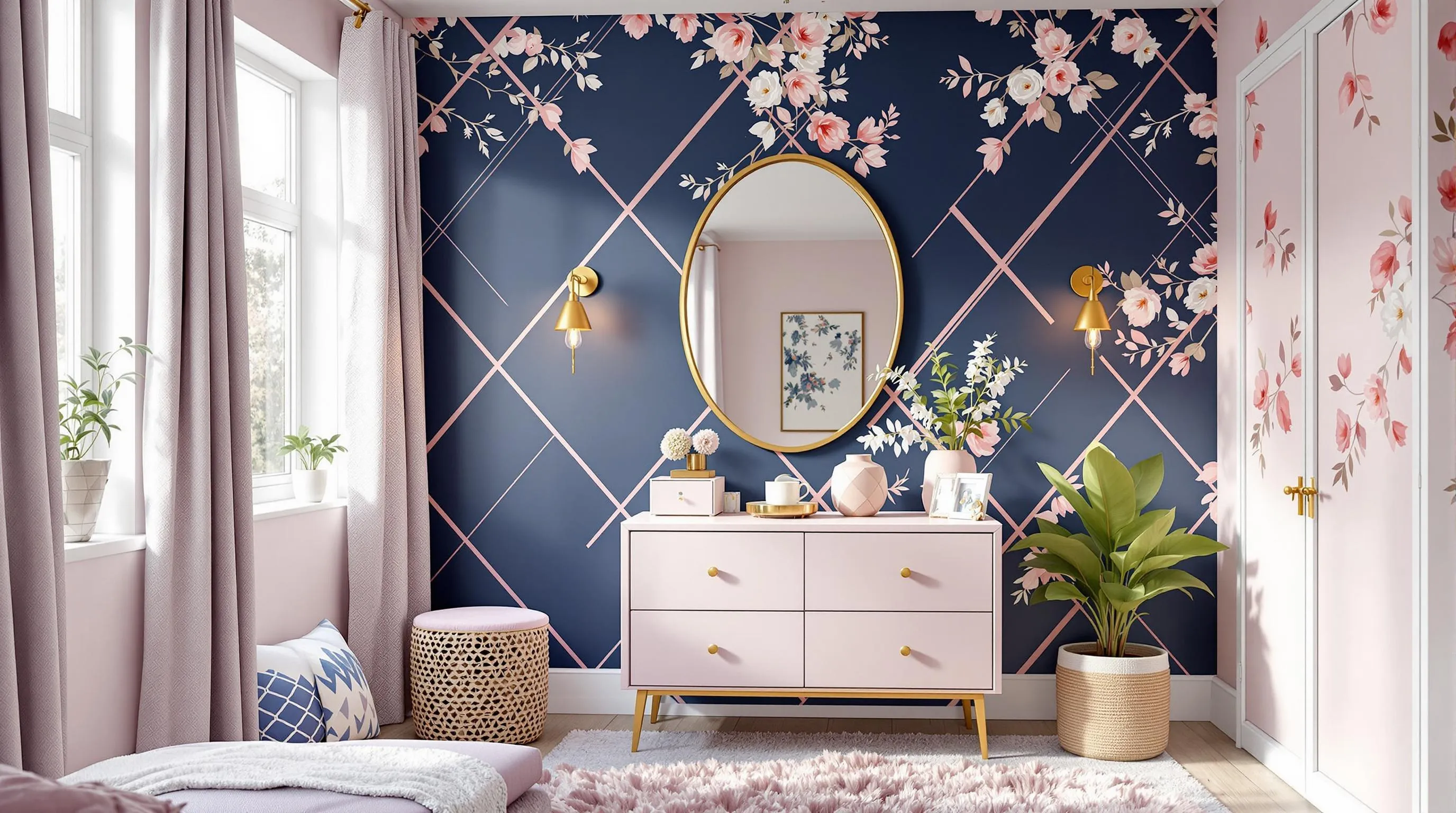
Bold Contrasts That Pop
Creating a focal point with deeper tones against lighter walls offers immediate visual interest without dominating the space. Navy or emerald accents provide sophisticated contrast when paired with neutral backgrounds, allowing the accent wall to become a standout feature. We’ve found that using these bold colors strategically draws attention while maintaining balance throughout the room, perfect for girls who appreciate dramatic elements in their personal space.
Geometric Patterns for Playful Sophistication
Geometric designs add dimension and personality to any girl’s room through triangles, stripes, or diamonds in complementary colors. Soft pink with gold geometric accents creates an especially elegant yet youthful combination that appeals to various age groups. These patterns work wonderfully on a single wall, providing visual stimulation without overwhelming the entire room’s design scheme.
Mural Accents That Inspire
Subtle floral or nature-inspired designs in muted tones introduce whimsy and personality to the space without dominating it. A delicate branch with birds or gentle watercolor flowers can transform an ordinary wall into an artistic statement. We recommend choosing mural elements that reflect your daughter’s interests while using colors that complement the room’s overall palette for a cohesive look.
Textured Finishes for Depth
Combining different paint finishes creates visual interest without changing colors. Lavender walls with satin sheen patterns against a matte background develop remarkable depth and dimension that catches light beautifully throughout the day. This technique works particularly well for girls who appreciate subtle sophistication rather than bold color statements.
Metallic Highlights That Shine
Incorporating gold or silver accents via stencils or trim adds a polished, upscale element to any girl’s room. These metallic touches catch light and create ever-changing visual interest against solid color backgrounds. We’ve seen stunning results when metallic highlights are used strategically on an accent wall, especially when they complement decorative elements like mirror frames or light fixtures throughout the room.
Ceiling and Trim Considerations: Completing Your Color Story
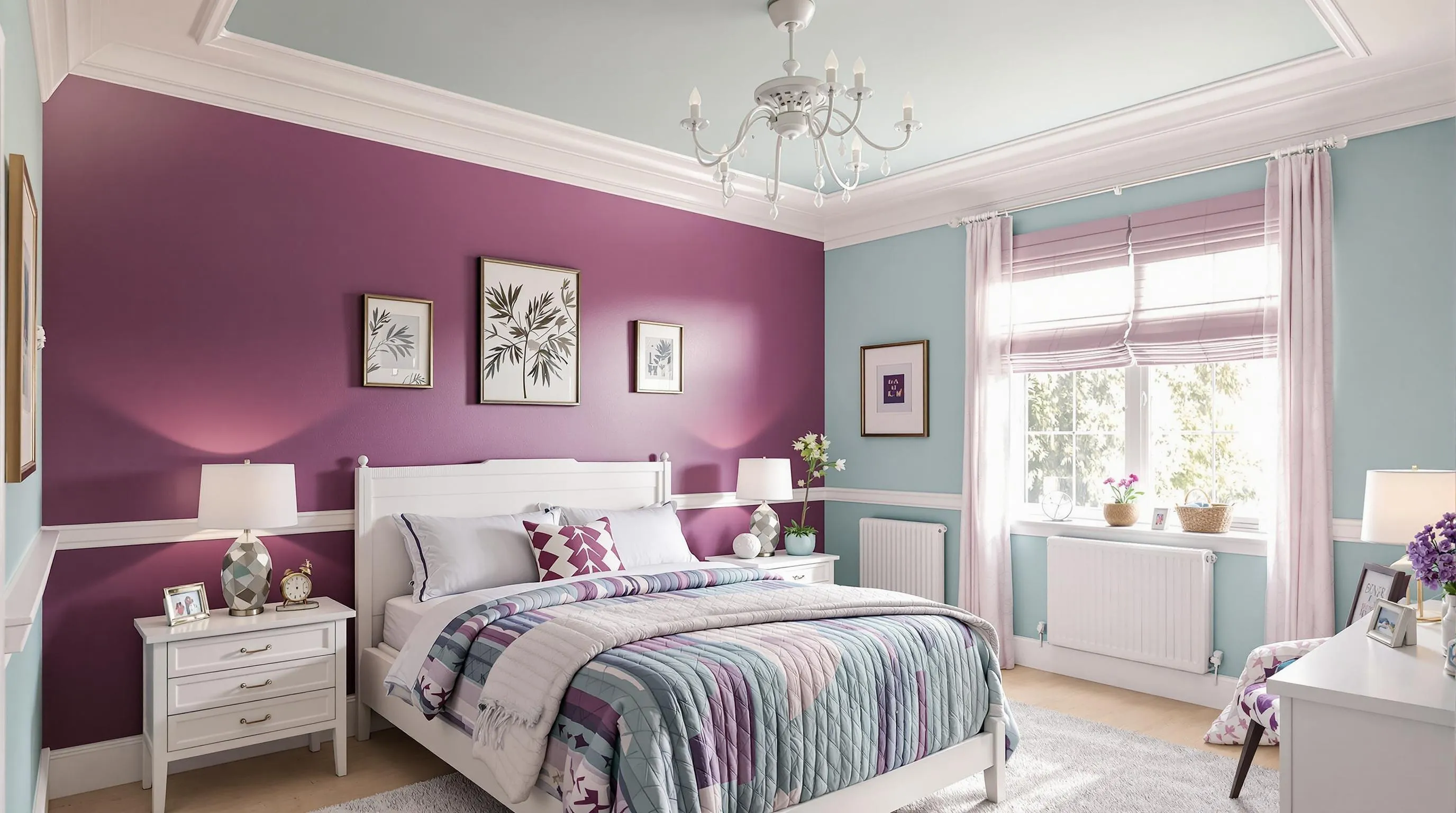
When designing a girl’s room, we often focus on wall colors while overlooking the importance of ceilings and trim that can dramatically enhance the overall aesthetic. Thoughtful ceiling and trim choices create visual harmony and define the room’s character in subtle yet impactful ways.
Creating Contrast with White Trim
White trim serves as a perfect counterbalance to bold wall colors, providing crisp definition to the room’s architectural features. Benjamin Moore Ivory White CC-130 offers a soft, warm undertone that beautifully complements vibrant walls without appearing stark. For rooms with cooler color schemes, White Sand OC-10 provides a slightly creamier alternative that maintains brightness while softening the contrast. These white trim options particularly enhance rooms with bold wall colors like plum or teal, creating a frame-like effect that keeps the space feeling open and airy.
Ceiling Color Strategies
Ceilings benefit from lighter tones than walls to avoid creating a visually heavy or closed-in feeling. A popular approach is matching ceiling color to trim for cohesive simplicity that draws the eye across the space. Alternatively, using a softer version of the wall color (typically 50% lighter) creates a subtle color flow from walls to ceiling. This technique works exceptionally well with Sherwin-Williams Misty SW-6232, where a lightened version on the ceiling maintains the gray palette while expanding the sense of height and space.
Balancing Bold Accent Walls
Accent walls in deeper shades require careful trim consideration to maintain balance throughout the room. Darker accent colors like plum or navy can be visually anchored with neutral trim that prevents the bold color from overwhelming the space. This balancing act keeps the room feeling bright and spacious while still showcasing personality through the accent color. The contrast between a bold accent wall and clean white trim creates a sophisticated look that can easily evolve as your daughter’s tastes mature over time.
Finish Considerations for Longevity
For trim in a girl’s room, semi-gloss finishes offer practical durability against fingerprints and everyday wear. This higher-sheen finish not only makes cleaning easier but also creates subtle light reflection that brightens the room. While walls typically feature eggshell or satin finishes, the slight contrast with semi-gloss trim adds dimension and visual interest to the overall color story without requiring additional colors or patterns.
Color Trends 2023: What’s Popular in Girls’ Room Design
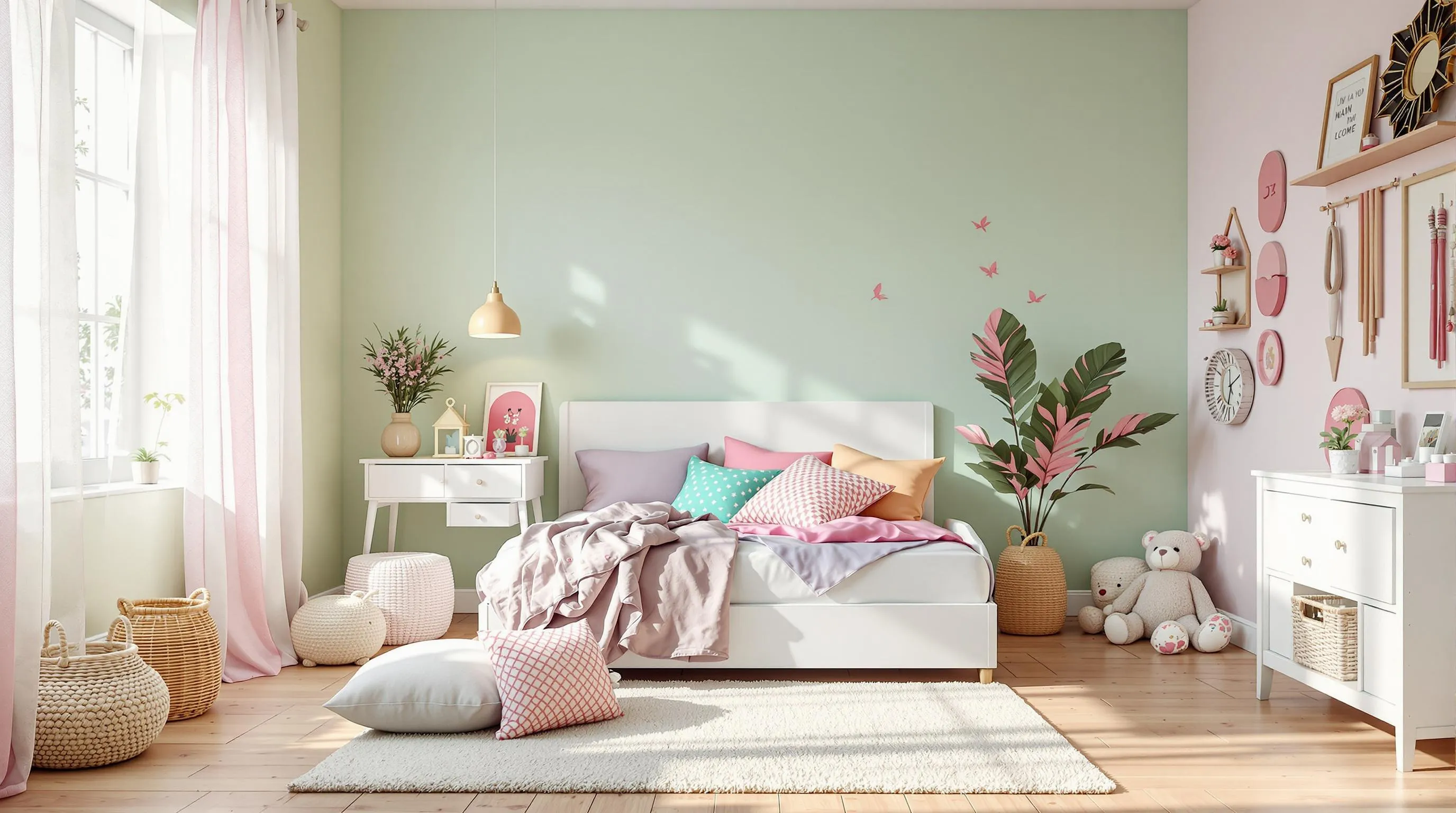
The paint color industry for girls’ rooms has evolved significantly in 2023, with several distinctive trends emerging that balance timeless appeal with fresh perspectives. Soft pastels continue to dominate the scene, but with sophisticated new undertones that offer longevity beyond early childhood. Nature-inspired hues have gained tremendous popularity, particularly pale green shades like Softened Green that provide a subtle, mossy backdrop for bold decorative elements.
Blues have made a surprising comeback in girls’ room design this year, with Ocean Air and Palladian Blue leading the charge as versatile options that create light, airy environments. These cooler tones work wonderfully for creating serene spaces that promote focus and relaxation. Lavender remains a top contender due to its scientifically-backed calming properties, making it perfect for creating peaceful sleeping environments for girls of all ages.
Neutral foundations have become increasingly important in 2023’s design approach, with Ivory White, White Sand, and Silver Satin (pale gray) serving as sophisticated backdrops that accommodate changing tastes. Parents are now thinking long-term, selecting colors that can easily transition through various age stages without requiring complete room makeovers.
Color blocking and accent walls continue to trend upward, allowing for personalization without overwhelming the space. Many designers recommend incorporating these bolder design elements while maintaining neutral trims and ceilings for balance. The overall direction for 2023 emphasizes creating adaptable, serene environments that can grow with girls through different developmental stages while still reflecting their unique personalities.
Practical Tips: Choosing Paint Finishes for Children’s Spaces
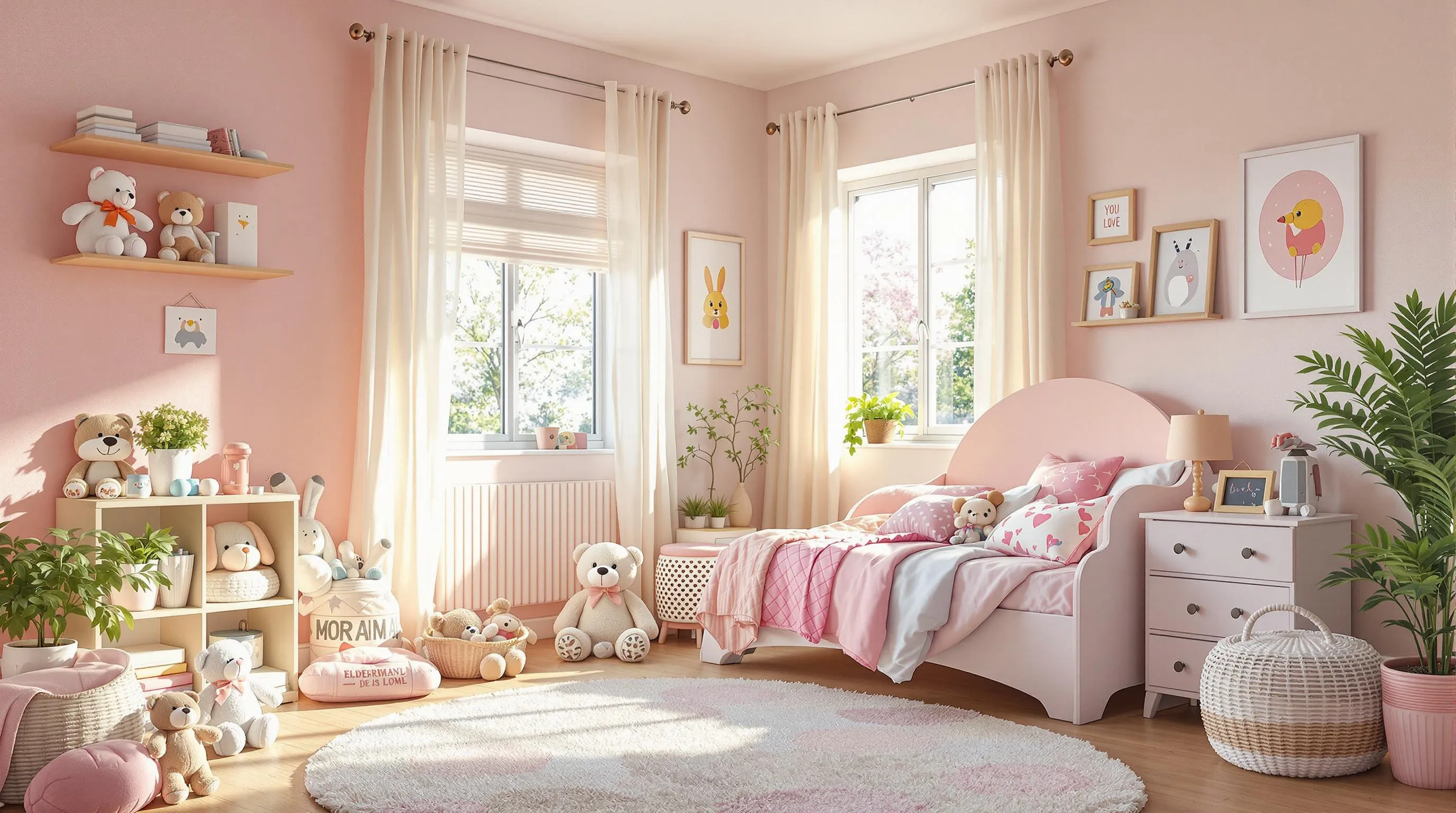
Durability Matters
Selecting semi-gloss or satin finishes for your daughter’s room provides exceptional durability against the inevitable wear and tear. These finishes resist scuffs, fingerprints, and crayon marks that often appear on children’s walls. We’ve found that rooms with semi-gloss paint can withstand regular cleaning without losing color vibrancy, making them perfect for active girls who love to express their creativity sometimes beyond paper boundaries. Unlike flat finishes that show damage easily, these more resilient options maintain their appearance for years.
Light Reflection Benefits
Paint finishes with higher gloss levels enhance natural light throughout the room, creating a brighter, more uplifting environment. Glossier options reflect window light beautifully, which can make smaller rooms appear more spacious and airy. Your daughter’s room will benefit from this increased brightness, especially during assignments time or creative play sessions. Many parents notice that rooms with light-reflecting finishes require less artificial lighting during daytime hours, creating a more inviting atmosphere.
Health and Safety Considerations
Low-VOC (volatile organic compound) paints represent the safest choice for children’s spaces, protecting indoor air quality and reducing potential respiratory irritants. These environmentally friendly options emit fewer harmful chemicals during and after application, making them ideal for sensitive children. We recommend allowing proper ventilation for at least 48 hours after painting, regardless of the paint type chosen. Many premium children’s room paints now come with antimicrobial properties that inhibit mold and mildew growth, adding another layer of health protection.
Complementary Style Options
The finish you choose should enhance your overall design without competing with decorative elements in your daughter’s room. Matte finishes provide sophisticated backdrops for rooms with many accessories or textured furnishings. For more minimalist spaces, higher-gloss finishes can add visual interest and become part of the design statement. The right finish creates harmony between walls and furnishings, allowing special items like artwork or a canopy bed to stand out appropriately rather than competing with overly shiny or flat wall surfaces.
Conclusion: Creating a Personalized Space She’ll Love for Years
Choosing the perfect paint color for your daughter’s room isn’t just about aesthetics—it’s about creating an environment where she can grow thrive and express herself. Whether you opt for calming lavenders timeless blush pinks or sophisticated neutrals the right shade will serve as the foundation for her personal sanctuary.
Remember to consider how colors affect mood and behavior while balancing current trends with long-term versatility. With durable finishes low-VOC formulations and thoughtful accent choices you’ll create a space that adapts to her changing preferences throughout the years.
Trust your instincts and involve your daughter in the decision-making process. After all her room should reflect her unique personality while providing the perfect backdrop for childhood memories dreams and adventures.
Frequently Asked Questions
What are the top paint colors for a girl’s room?
The top recommended paint colors for a girl’s room include Soft Lavender, Blush Pink, Mint Green, Sky Blue, Sunny Yellow, Coral, Periwinkle, Sage Green, Peachy Cream, and Lilac Gray. These colors are chosen for their ability to inspire creativity, adapt to changing tastes, and create environments that grow with your daughter from childhood through the teen years.
How do paint colors affect a child’s mood and behavior?
Paint colors significantly impact mood and behavior through color psychology. Soft pinks and lavenders promote relaxation and better sleep, while sunshine yellow and turquoise stimulate creativity and energy. Blues reduce stress and encourage open-minded thinking. Choosing the right color can support your daughter’s emotional well-being and development throughout her growing years.
What are the best paint finishes for a girl’s bedroom?
Semi-gloss or satin finishes are ideal for girls’ bedrooms due to their durability against scuffs, fingerprints, and general wear and tear. These finishes are also easier to clean, making them practical for active children. Additionally, they reflect light well, creating a brighter atmosphere in the room while complementing the overall design aesthetic.
Should I consider low-VOC paints for my child’s room?
Absolutely. Low-VOC (Volatile Organic Compounds) paints are strongly recommended for children’s rooms as they release fewer harmful chemicals into the air, creating a healthier environment. Children are more susceptible to air quality issues, so choosing these environmentally friendly options helps protect their respiratory health while maintaining excellent color quality and durability.
What’s trending in girl’s room paint colors for 2023?
The 2023 trends include sophisticated pastels with complex undertones, nature-inspired hues like Softened Green, and comeback blues such as Ocean Air and Palladian Blue. Lavender remains popular for its calming properties. Neutral foundations like Ivory White and Silver Satin provide adaptability, while color blocking and accent walls offer personalization while maintaining balance with neutral trims.
How can I create an accent wall in my daughter’s room?
Create an accent wall by using bold contrasts like navy or emerald against lighter walls, adding geometric patterns in complementary colors, or incorporating subtle mural designs. Consider textured finishes or metallic highlights for added depth and elegance. An accent wall adds visual interest without overwhelming the space, allowing for personalization as your daughter’s tastes evolve.
What colors work best for ceilings and trim in a girl’s room?
For trim, white creates crisp contrast with bold wall colors—Benjamin Moore’s Ivory White and White Sand work well. Ceilings look best in lighter tones to avoid a heavy feel—either match the trim or use a lighter version of the wall color for cohesion. Balance bold accent walls with neutral trim to maintain brightness, and consider semi-gloss finishes for durability and visual interest.
How can I choose a paint color that will grow with my daughter?
Select adaptable colors like sophisticated neutrals (warm gray), soft pastels with complex undertones, or timeless hues like blush pink or sage green. Start with a neutral base that allows for changing accessories as she grows. Consider colors with psychological benefits that support different developmental stages, and involve your daughter in the decision to ensure the color reflects her personality.
What are good paint options for a themed room?
For themed rooms, start with versatile base colors like Sherwin-Williams Dew Drop that can adapt as interests change. Choose colors that complement the theme without overwhelming it—soft blues for ocean themes, gentle greens for nature themes, or warm neutrals for flexible styling. Incorporate themed elements through accessories rather than permanent features for easy updates as your daughter grows.
Which paint colors are best for small girls’ bedrooms?
Light, cool tones like Sky Blue, Mint Green, and Lavender create an illusion of space in small bedrooms. Soft neutrals such as Lilac Gray and Peachy Cream reflect light and make rooms feel larger. Consider painting trim the same color as walls for a seamless look, or use vertical stripes to create the impression of height. Limit strong contrasts that can make the space feel choppy.

